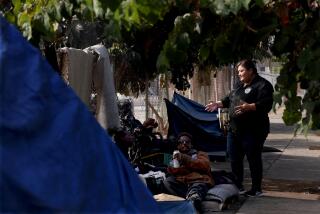Keep Promise to Working Poor
- Share via
A proposal to revitalize Anaheim’s troubled Jeffrey-Lynne neighborhood is on the table. While a city-driven redevelopment plan makes some sense, officials must be careful that it doesn’t become a gentrification plan in disguise, driving out the working poor and creating a publicly financed bonanza for developers. Others with an interest, Disneyland and local church and civic groups, should be part of finding answers for this neighborhood that has defied solutions in the past.
For years, the troubles of this one neighborhood have defined for Orange County what it means to have urban problems within a suburban county. Jeffrey-Lynne was an important reason for the mobilization of city resources and the activism of civic and faith-based groups in Anaheim. In many ways, this response has been a model for others facing similar difficulties.
But those problems have proved intractable, even as they have spawned creative solutions. Since the mid-1980s, various groups have lined up to battle poverty and urban decay. Community policing and antigang programs all have been brought to bear.
As much as those efforts have reflected a community’s resolve, they also have pointed up the stubborn difficulty of the neighborhood’s problems. In this area of about 700 apartments, crime has had a way of rebounding despite the best efforts of the city to address substandard housing, absentee landlords and crime.
This week, the city is scheduled to consider a $54-million affordable housing project designed to renovate more than half the apartments in the neighborhood. There are concerns among residents that the new apartments will not be as affordable as advertised, and that many in currently overcrowded units will end up being driven to the street.
It’s hard to make a convincing case that less-drastic measures of dealing with the area’s problems are the way to go. Some of the building owners say they can do the job, but while that may be so in individual cases, the overall record over a long period of time is poor. City officials have responded to various calls to put pressure on lax building owners, but still there are leaky roofs and deteriorating conditions.
Whatever course of action is taken, it is important that these residents be treated well. Many are part of the low-wage labor force that serves the growing economy of the region, but they do not share in the prosperity. Local businesses such as Disneyland benefit from having this labor pool available. It is important that the housing needs of this group be addressed for any interim reconstruction period and for the long term. Where necessary, provisions for housing in other areas should be made.
The city has promised, correctly, that none will go homeless and that it will use public funds to subsidize differences in rent for those who must move. These pledges must be honored. Although many residents will be allowed to return after construction, the concern that more than 1,000 people currently living in the area could be displaced is a real one.










